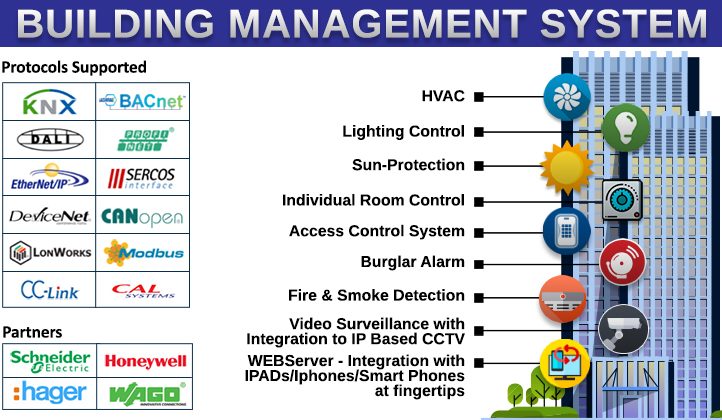BMS
This course includes:- 8.5 hours lectures
- 2 hours practicle
- 16 downloadable resources
- Certificate of completion
A Building Management System (BMS), otherwise known as a building automation system (BAS) or a building energy management system (BEMS), is a computer-based control system installed in buildings that controls and monitors the building's mechanical and electrical equipment such as ventilation, lighting, power systems, fire systems, and security systems. A BMS consists of software and hardware; the software program, usually configured in a hierarchical manner, can be proprietary, using such protocols as C-Bus, Profibus, and so on. Vendors are also producing a BMS that integrates the use of Internet protocols and open standards such as DeviceNet, SOAP, XML, BACnet, LonWorks, Modbus or KNX. A BEMS may focus on a building's energy use and performance, or occupant choice, rather than a wider range of building functions.
Building management systems are most commonly implemented in large projects with extensive mechanical, HVAC, and electrical systems. Systems linked to a BMS typically represent 40% of a building's energy usage; if lighting is included, this number approaches to 70%. BMS systems are a critical component to managing energy demand. Improperly configured BMS systems are believed to account for 20% of building energy usage, or approximately 8% of total energy usage in the United Statesn addition to controlling the building's internal environment, BMS systems are sometimes linked to access control (turnstiles and access doors controlling who is allowed access and egress to the building) or other security systems such as closed-circuit television (CCTV) and motion detectors. Fire alarm systems and elevators are also sometimes linked to a BMS for monitoring. In case a fire is detected then only the fire alarm panel could close dampers in the ventilation system to stop smoke spreading, shut down air handlers, start smoke evacuation fans, and send all the elevators to the ground floor and park them to prevent people from using them.
The Building Management System monitors each area in the following ways:
The building management system can monitor different sensors such as smoke, gas leak, and door sensors that are strategically installed in the building. BMS can also log all relevant data readings and immediately notify the central monitoring for easy access and centralized communication. Furthermore, data from BMS is real-time, having this kind of technology enables to cut personnel from rooming and physical daily checking of all relevant elements within a building.
Building automation also provides complete control of building lightings for common areas, parking, and other essential areas within the vicinity. It allows control of water pumps and monitoring of water tank status. It can also monitor the status of various sub-systems that need constant monitoring such as elevators, generators, and more.
It can also unlock door facilities remotely providing convenience to building occupants. Most importantly BMS secured and prevent possible physical and cyber threats allowing building managers to have a peaceful mind.

Based on All reviews
Heather Joanne
Good
Sample Review
Penelope Rachel
Good
Sample Review.
Leonard Richard
Very Good
Sample Review